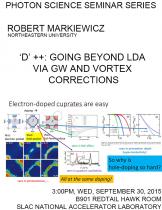Speaker: Robert Markiewicz, Northeastern University
Program Description
A large variety of approaches have been implemented for extending LDA calculations of band structure to account for stronger calculations. In particular, GW calculations are used to calculate the electronic self-energy, but there is debate about whether non-self-consistent [or G0W0] or self-consistent [GW] calculations perform better. We have found that as correlation strength increases the G0W0 approach fails, but that this can be corrected by a self-consistent approach, called quasiparticle-GW [QPGW] or GZWZ. While considerably simpler than full GW, this new approach has proven to be readily adaptable to a variety of spectroscopies, giving good agreement for a number of properties of cuprates. In particular, the high momentum-space resolution has allowed the observation of competing density- wave phases in the phase diagrams of many cuprates.
While the QPGW approach provides a good starting point for most spectroscopies, the finite- temperature results are limited in that the phase transitions are mean-field. Thus, the superconducting transition lies at too high a temperature when short-range fluctuations are important. Worse, the pseudogap is classified as merely a mean field antiferromagnetic transition. To better understand pseudogap physics, we have recently extended the GW calculation to include a self-consistent vertex correction. This reveals that pseudogap physics is a strong coupling effect: significant mode-coupling leads to a breakdown of the random-phase approximation and a condensation bottleneck, leading to extended ranges of short-range order.
Tanmoy Das, R. S. Markiewicz, A. Bansil, Advances in Physics 63, 151-266 (2014)
R.S. Markiewicz, I.G. Buda, P. Mistark, A. Bansil, arXiv:1505.04770.





